Mastering herbal tea blending allows you to create customized infusions tailored to your taste and wellness needs. Start with essential herbs like chamomile, peppermint, and rooibos as your base, then add floral herbs, spices, and citrus elements for complexity. Understand flavor profiles and experiment with combinations to achieve balance. Consider health benefits when crafting blends, adjusting ratios for desired effects. Proper drying and storage techniques guarantee peak freshness and potency. Learn steeping methods to extract the best flavors, and explore food pairings to enhance your tea experience. With practice, you'll develop the skills to craft signature blends that delight your senses and nourish your body.
Essential Herbs for Tea Blending

The art of tea blending begins with selecting the right herbs. To create your own unique infusions, you'll need to familiarize yourself with a variety of herbs and their flavors. Start with versatile base herbs like chamomile, peppermint, and rooibos. These provide a solid foundation for your blends and pair well with other ingredients.
For floral notes, consider rose petals, lavender, and hibiscus. These add a delicate aroma and vibrant color to your teas. Spices such as cinnamon, ginger, and cardamom can bring warmth and complexity to your blends.
Don't forget about citrusy herbs like lemongrass and lemon balm, which offer an invigorating twist. Explore adaptogens like ashwagandha and holy basil for their potential health benefits. Calming herbs such as valerian root and passionflower are excellent for evening blends.
For a caffeine boost, incorporate yerba mate or guayusa. When selecting herbs, opt for high-quality, organic options whenever possible. This guarantees the best flavor and minimizes exposure to pesticides.
Remember to research each herb's properties and potential interactions before using them in your blends.
Understanding Flavor Profiles and Combinations
To create balanced and flavorful herbal tea blends, you'll need to understand complementary herb pairings and how they interact.
Start by selecting a base herb that forms the foundation of your blend, then add accent herbs to enhance or contrast the primary flavors.
Consider the various flavor notes—such as earthy, floral, or citrusy—to craft a well-rounded and appealing tea experience.
Complementary Herb Pairings
Mastering the art of herbal tea blending requires an understanding of complementary herb pairings and their flavor profiles. You'll find that certain herbs naturally enhance each other's flavors, creating harmonious and well-balanced infusions. For example, chamomile's sweet, floral notes pair beautifully with the light, citrusy taste of lemongrass, resulting in a soothing blend perfect for relaxation.
Consider combining peppermint with spearmint for a revitalizing, cooling sensation, or mix it with licorice root for a naturally sweet and minty concoction. Ginger's spicy kick complements the earthy warmth of turmeric, creating a zesty, anti-inflammatory blend.
For a more complex flavor profile, try pairing hibiscus with rosehips and orange peel, balancing tartness with subtle sweetness. When exploring herb pairings, don't shy away from unconventional combinations.
Lavender's floral aroma can add depth to a blend of lemon balm and holy basil, while fennel seed's licorice-like flavor can enhance the sweetness of chrysanthemum flowers. Remember to start with small quantities and adjust ratios to suit your taste preferences.
Base, Accent, Flavor Notes
Every successful herbal tea blend consists of three key components: base notes, accent notes, and flavor notes. Understanding these elements will help you create balanced and flavorful herbal infusions.
Base notes form the foundation of your blend, providing body and depth. They're typically mild-flavored herbs like chamomile, rooibos, or nettle. You'll want to use these in larger quantities, making up 50-70% of your blend.
Accent notes add complexity and interest to your tea. They're stronger-flavored herbs like peppermint, lemongrass, or ginger. Use these sparingly, around 20-30% of your blend, to avoid overpowering the base.
Flavor notes are the standout tastes in your blend. These can be bold spices like cinnamon, fruit pieces, or aromatic flowers like lavender. They should make up only 10-20% of your blend but will considerably impact the overall taste.
When combining these elements, consider how they'll interact. Start with your base, then add accents that complement it. Finally, incorporate flavor notes that enhance the blend's character.
Experiment with different ratios to find your perfect balance.
Balancing Taste and Health Benefits
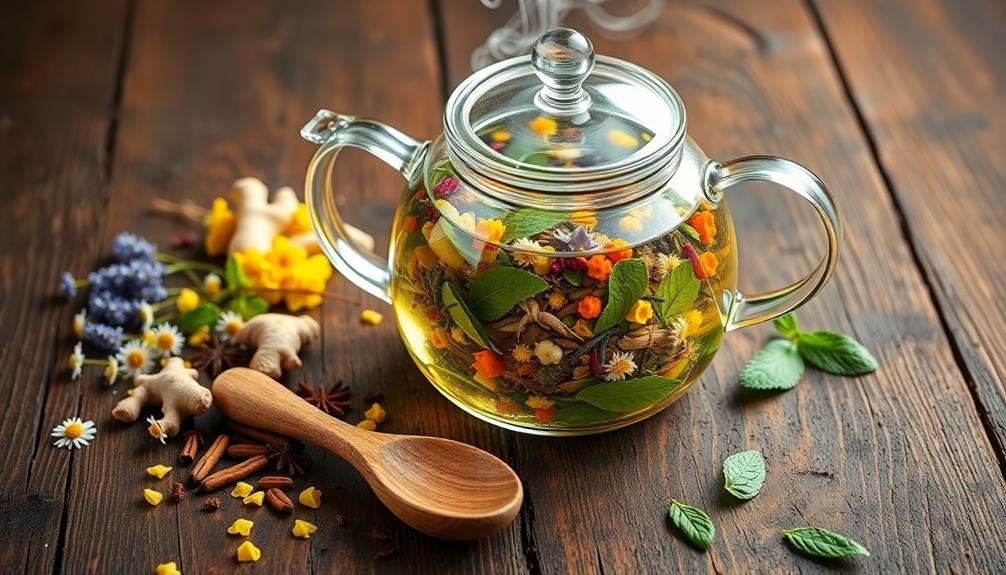
When crafting herbal teas, you'll want to balance flavor profiles and health benefits to create a satisfying and effective brew.
Consider pairing complementary herbs that not only taste great together but also work synergistically to enhance therapeutic effects.
You can adjust the strength and intensity of your tea by varying steeping times and ratios, allowing you to fine-tune both taste and potency to your liking.
Complementary Flavor Profiles
In the domain of herbal tea crafting, balancing flavor profiles with health benefits is an art form. To create harmonious blends, you'll need to understand how different herbs interact and complement each other.
Start by categorizing herbs into flavor groups: sweet, bitter, spicy, floral, and earthy. Sweet herbs like licorice root or stevia can balance bitter flavors from dandelion or milk thistle. Spicy herbs such as ginger or cinnamon pair well with earthy notes from rooibos or nettle.
Consider the intensity of each herb and adjust quantities accordingly. Strong flavors like peppermint or lemon balm can easily overpower milder herbs, so use them sparingly. Experiment with ratios to find the perfect balance. For example, combine 2 parts chamomile with 1 part lavender and a pinch of lemon verbena for a soothing blend.
Don't forget about visual appeal and mouthfeel. Include ingredients like rose petals or cornflowers for color, and add marshmallow root or slippery elm for a smooth texture.
Therapeutic Herb Combinations
Creating therapeutic herb combinations requires a delicate balance between taste and health benefits. You'll want to blend herbs that not only complement each other flavor-wise but also work together to address specific health concerns. Start by identifying your primary wellness goal, then select herbs known for their efficacy in that area.
Consider these popular therapeutic combinations:
| Wellness Goal | Herb Combination | Benefits |
|---|---|---|
| Stress Relief | Chamomile, Lavender, Lemon Balm | Calming, promotes relaxation |
| Immune Boost | Echinacea, Elder, Ginger | Strengthens immune system |
| Digestion Aid | Peppermint, Fennel, Licorice | Soothes stomach, reduces bloating |
| Sleep Support | Valerian, Passionflower, Hops | Improves sleep quality |
| Energy Boost | Green Tea, Ginseng, Rhodiola | Enhances mental clarity and stamina |
When blending, start with equal parts of each herb and adjust to taste. Remember, some herbs can interact with medications or have side effects, so research thoroughly before use. It's also wise to consult with a healthcare professional, especially if you're pregnant, nursing, or have existing health conditions. By carefully selecting and combining therapeutic herbs, you'll create teas that not only taste great but also support your overall well-being.
Adjusting Strength and Intensity
The strength-intensity balance of herbal teas can make or break your brew's effectiveness and enjoyment. To adjust this balance, start by considering your health goals and taste preferences. For stronger flavors and increased potency, use more herbs or steep longer. However, be cautious – over-steeping can lead to bitterness and may reduce some beneficial compounds.
If you're seeking a milder taste, use fewer herbs or shorten the steeping time. You can also add neutral herbs like chamomile or lemon balm to soften intense flavors without compromising therapeutic effects.
Water temperature plays an essential role too; delicate herbs like mint prefer cooler water, while roots and barks need hotter temperatures to release their properties.
Don't forget about timing. Some herbs, like green tea, release beneficial compounds quickly, while others, such as ginger or licorice root, require longer steeping. Experiment with cold brewing for a smoother taste and different phytochemical profile.
Proper Drying and Storage Techniques
Proper drying and storage techniques are essential for preserving the flavor, aroma, and medicinal properties of your herbal tea ingredients.
To dry herbs effectively, harvest them on a dry morning after the dew has evaporated. Gently rinse and pat them dry, then bundle small amounts together with string. Hang these bundles in a warm, dry, well-ventilated area away from direct sunlight. Alternatively, use a food dehydrator or spread herbs on drying racks.
Your herbs are fully dried when they crumble easily. Store them in airtight containers, preferably glass jars with tight-fitting lids. Keep these containers in a cool, dark place to maintain freshness. Label each jar with the herb name and drying date. For best flavor, use dried herbs within six months to a year.
When storing tea blends, keep different ingredients separate until you're ready to brew. This prevents stronger herbs from overpowering more delicate ones.
If you've created a blend, store it in small batches to maintain freshness. Always check your stored herbs for signs of mold or unusual odors before use, discarding any that seem off.
Crafting Signature Herbal Tea Blends

With your herbs properly dried and stored, you're ready to release your creativity by crafting signature herbal tea blends. Start by understanding the flavor profiles of your available herbs.
Categorize them into base, middle, and top notes. Base notes provide the foundation, middle notes add body, and top notes bring aroma and brightness.
Begin with a simple blend of two or three complementary herbs. For example, pair chamomile with lavender for a calming blend, or mix peppermint with lemon balm for a revitalizing infusion.
As you gain confidence, experiment with more complex combinations. Consider the purpose of your blend. Are you aiming for a relaxing nighttime tea, an energizing morning boost, or a digestive aid? Let this guide your herb selection.
Don't forget to balance flavors – combine sweet, bitter, and aromatic elements for a well-rounded taste. Measure your herbs carefully, starting with a ratio of 1 part of each herb. Adjust proportions based on taste preferences and potency.
Keep detailed notes of your experiments, including measurements and steeping times. This will help you replicate successful blends and refine your recipes over time.
Steeping Methods for Optimal Flavor
For ideal flavor extraction, mastering the art of steeping is crucial. Different herbs require varied steeping times and temperatures to release their best flavors and benefits. Generally, delicate herbs like mint or chamomile need shorter steeping times and cooler water, while robust herbs like ginger or rosehip can withstand longer steeping and hotter temperatures.
To achieve the perfect brew, you'll want to take these factors into account:
- Water temperature: Use a thermometer to guarantee accuracy. Green and white teas typically require water around 160-180°F, while black teas and most herbs can handle boiling water at 212°F.
- Steeping time: Start with 3-5 minutes for most herbs, adjusting based on personal preference and the specific blend.
- Herb-to-water ratio: A general rule is 1-2 teaspoons of dried herbs per cup of water, but experiment to find your ideal strength.
Don't forget to cover your tea while it steeps to retain heat and essential oils.
If you're using fresh herbs, you'll need to use more and steep for a longer duration. Always taste your tea periodically during steeping to avoid over-extraction, which can lead to bitterness.
Pairing Herbal Teas With Foods
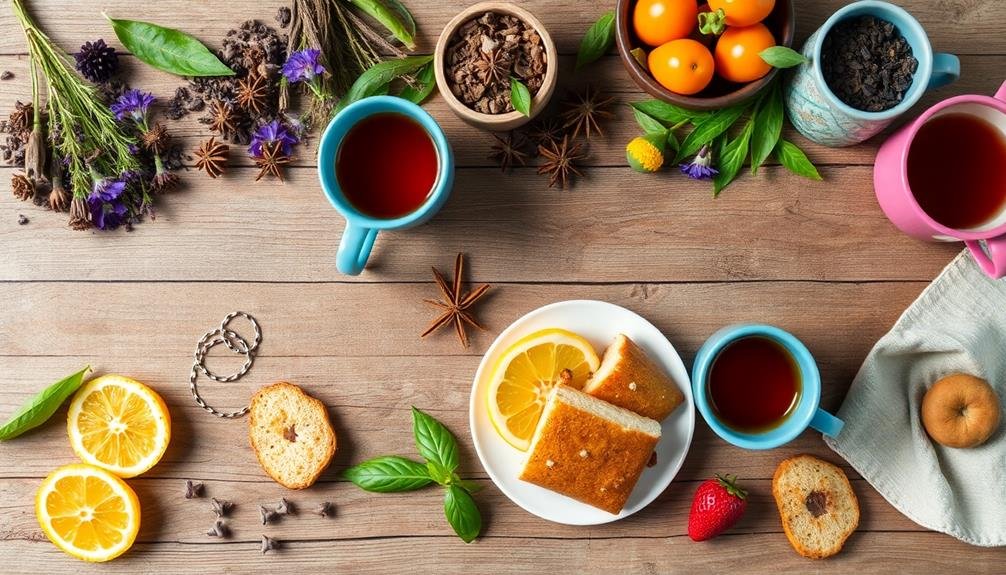
Just as mastering steeping techniques enhances your herbal tea experience, pairing your brews with complementary foods can elevate both the tea and the meal.
Consider the flavor profile of your herbal tea when selecting food pairings. Light, floral teas like chamomile or lavender pair well with delicate pastries or fruit tarts. For a more robust pairing, try matching peppermint tea with dark chocolate desserts or cheese plates.
Citrusy herbal blends complement seafood dishes and light salads, while earthy teas like rooibos or nettle can stand up to hearty stews and roasted meats.
Don't forget about temperature contrasts; a chilled hibiscus tea can be invigorating alongside spicy cuisine.
For breakfast, pair ginger tea with oatmeal or whole-grain toast to aid digestion.
At lunch, try a lemon balm tea with a Mediterranean-inspired sandwich.
For dinner, serve a rosemary-infused blend with grilled vegetables and lean proteins.
Frequently Asked Questions
Can Pregnant Women Safely Drink All Herbal Teas?
You shouldn't assume all herbal teas are safe during pregnancy. Some can be harmful to you or your baby. It's best to consult your doctor before consuming any herbal teas while pregnant. Stick to approved options.
How Long Do Homemade Herbal Tea Blends Typically Stay Fresh?
You'll find your homemade herbal tea blends typically stay fresh for 6-12 months when stored properly. Keep them in airtight containers away from light, heat, and moisture. For the best flavor, use them within 3-6 months.
Are There Any Herbs That Should Never Be Mixed Together?
You should avoid mixing certain herbs due to potential interactions. Don't combine St. John's Wort with antidepressants, or licorice root with blood pressure medications. It's best to research each herb's properties and consult a healthcare professional before blending.
Can I Use Fresh Herbs Instead of Dried Ones for Tea Blending?
Yes, you can use fresh herbs for tea blending. They'll give you a more vibrant flavor, but you'll need to use more fresh herbs than dried ones. Remember to wash them thoroughly and adjust steeping times accordingly.
Are There Any Potential Side Effects From Drinking Too Much Herbal Tea?
Yes, you can experience side effects from excessive herbal tea consumption. You might encounter digestive issues, sleep disturbances, or interactions with medications. It's best to drink in moderation and consult a doctor if you're concerned.
In Summary
You've now revealed the secrets of herbal tea mastery. With your newfound knowledge of herbs, flavor profiles, and blending techniques, you're ready to create unique infusions tailored to your taste and health needs. Don't forget to properly dry and store your herbs, and experiment with different steeping methods. As you craft your signature blends, you'll discover endless possibilities for pairing them with foods. Embrace your inner tea artisan and let your creativity steep!

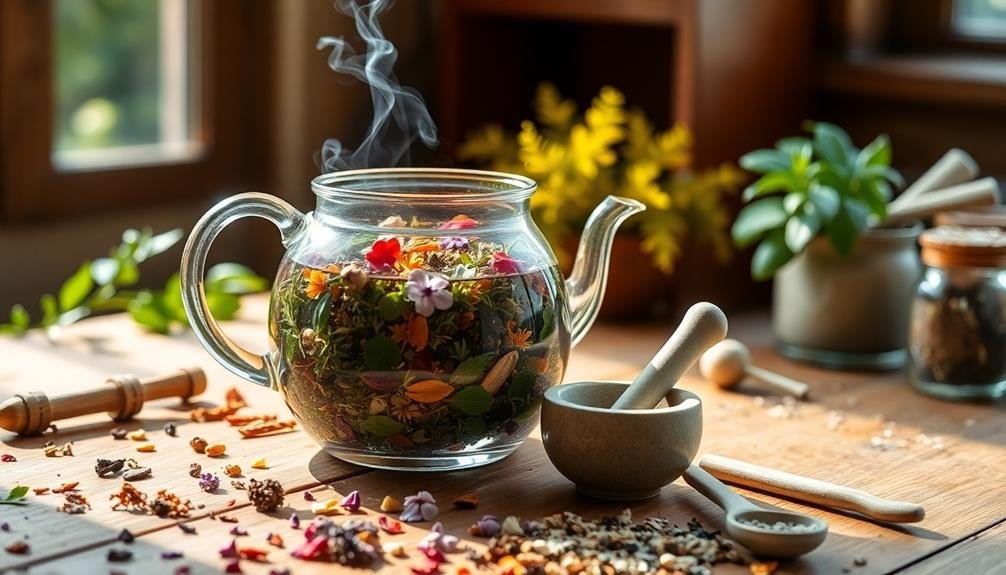
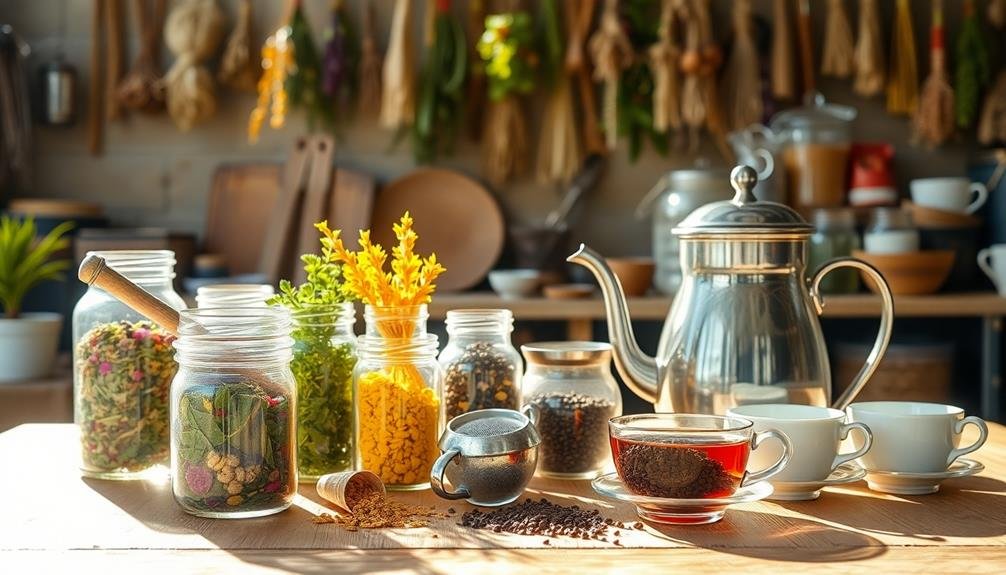
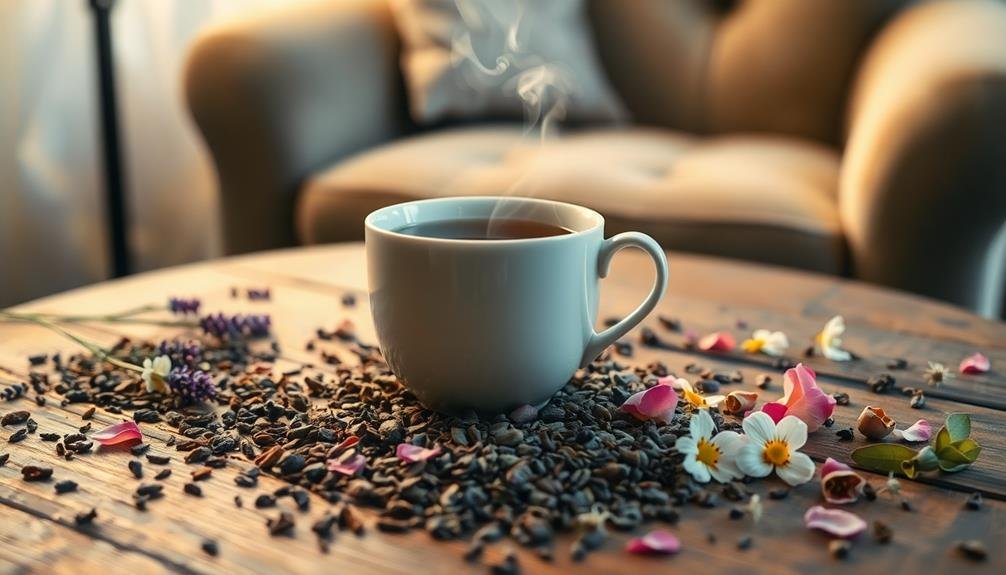
Leave a Reply